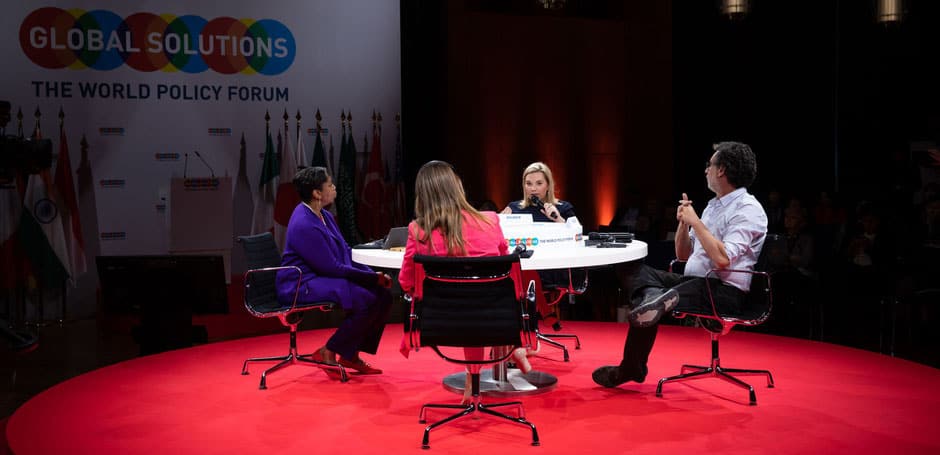A commentary by Mercedes Monzon Egana, Alejandra van der Biest (YGCs, 2019)
The annual Global Solutions Summit brings together researchers, academics, policymakers and thought-leaders from inter-sectoral backgrounds to challenge today’s paradigms and discuss future collective action. In addition to the Summit, the Global Solutions Initiative also selects 90 Young Global Changer from around the globe, to participate in a three-day Summer School. This Summer School is as an arena for young leaders to challenge the status quo of policy making.
The annual summits intend to be more than a conference: They aim to provide a space for dialogue to develop innovative and thoughtful policy recommendations for the G20’s decision-makers. The two-day summit serves as a stepping stone for the future T20 and G20 Conferences, highlighting the crucial problematic and state of the art in policy making. Nonetheless, one cross-sector theme was left aside on this year’s summit which dealt with the topic of Paradigm Change.
In the words of Jason Blackstock, a professor at the University College London and one of the summit’s panel moderators: “We acknowledge there is a lack of diversity on this panel but please understand this is what was available in terms of time. We understand this is not representative.”
As Young Global Changers, this was not the first time we encountered an all-male, all-white panel. As presented in the program, some ten of the 60 sessions, or 17 percent, did not have any female representation. Is this the example we want to set for the future G20 generations?

A known representation problem
The lack of representation on panels is not a new topic. One individual from the Argentinean T20 organizing team said the issue was also brought up at the 2018 summit. The expectation was that the lack of women on all panels would be addressed this year.
What reasons could there be for a lack of female representation? We believe there are three possible explanations.
The first, could be a lack of will from the organizers to find female speakers. However, a counter-argument was given by the organizing Global Solutions Initiative, who explained that when they started organizing the event the gender quota for participants was 50/50 in terms of the professionals, academics, policymakers, and so on.
A second argument is that the number of speakers who were invited, but did not confirm their participation, was higher among women than men. “We tried to have balanced panels” the organizers explained “but many women simply were not available. In our experience female speakers in relevant positions get invited to very many panels and conferences and do tend to decline more often than their male counterparts”, the organizers explained.
A symptom of a larger problem
This leads us to the final argument, which is that as of today there simply is a significantly lower number of women in key decision-making positions who can be invited to the panels. The Global Solutions Initiative noted that there are not as many women recognized in high-level positions. This argument is supported by the World Bank Gender Data Portal, for example, which states that as of 2016 in a country like Germany the female share of employment in senior and middle-management positions was still only at 29 percent.
One participant of the panel on Building Social Cohesion by Fighting Inequality congratulated the organizers for the diversity of speakers, saying it allowed a rich discussion from complementary perspectives. This panel was an exceptional example of gender equality with three female speakers, two male speakers and a rich combination of cultural backgrounds.
This is an example of best practice and is exactly the legacy the Global Solutions Summit should be aiming for. Argentina, which held the G20 presidency in 2018, followed a non-written rule of no all-male panels during the T20 2018 as a top priority. Unfortunately, it seems this rule did not stick.
When talking about “Paradigm Change” and the need for systematic changes, as we did during the Summit and the Summer School, we must ask ourselves how can discuss changing the world when half of its population, women, are still not included properly.
In the end, the gender and diversity misrepresentation at the Global Solutions Summit is a sample of the still unrepresentative, unequal, and non-inclusive system we live in. Multilateral scenarios such as the annual Global Solutions Summit should revise their position on these cross-sector problems and consider how they can serve as a trampoline to bring these issues into the heart of every discussion. Looking further we ask ourselves: What will the future of gender and diversity look like for T20 Japan and beyond?
In this regard the organizers of the Summit still have plenty of work to do, but two numbers give hope for the future: Among the 1.600 attendees of the summit 50% were women. When looking at the new generation of global leaders this number was even higher. Of this year’s 90 Young Global Changers almost two thirds (63%) were female.
The views and opinions expressed in this article are those of the authors and do not necessarily reflect the views of the Global Solutions Initiative.
